This pub takes its position by the old London-to-Rye road, once a key coaching route. It is thought that this building dates from the 1800s, when villas were being built to accommodate the rich merchants who were moving out of the city.
The text reads: Tommy Steele bought a house for his parents in Ravensbourne Park, and lived there himself until the 1960s. Born Thomas Hicks in Bermondsey (1936), he served as a merchant seaman, before his skiffle group were discovered in the 21s coffee bar in Soho. By 1957 he had become Britain’s top rock n’ roll star.
In the 1960s Tommy Steele became a family entertainers, and in 1993 he was honoured for his “outstanding contribution to show business”.
A framed drawing, print and text about Ernest Dowson.
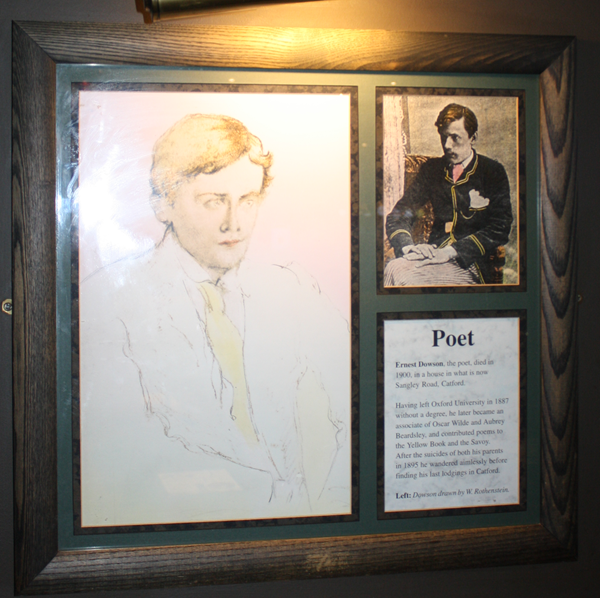
The text reads: Ernest Dowson, the poet, died in 1900, in a house what is now Sangley Road, Catford.
Having left Oxford University in 1887 without a degree, he later became an associate of Oscar Wilde and Aubrey Beardsley, and continued poems to the Yellow Book and the Savoy. After the suicides of both his parents in 1895 he wandered aimlessly before finding his last lodgings in Catford.
Left: Dowson drawn by W. Rothenstein.
Framed prints and drawings about nursery pioneers in the area.
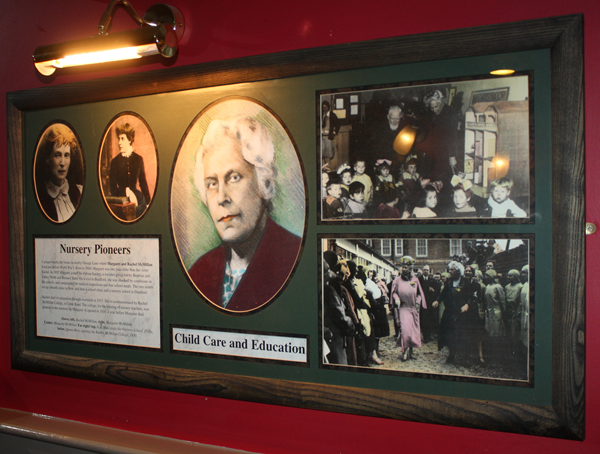
The text reads: A plaque marks the house in nearby George Lane where Margaret and Rachel McMillan lived just before World War I. Born in 1860, Margaret was one year older than her sister Rachel. In 19892 Margaret joined the Fabian Society, a socialist group led by Beatrice and Sidney Web and Bernard Shaw. On a visit to Bradford, she was shocked by conditions in the schools, and campaigned for medical inspections and free school meals. The two sisters set up a health clinic in Bow, and then a school clinic and a nursery school in Deptford.
Rachel died of exhaustion through overwork in 1917. She is commemorated by Rachel McMillan College, in Creek Road. The college, for the training of nursery teachers, was planned in her memory by Margaret. It opened in 1930, a year before Margaret died.
Above: left, Rachel McMillan, right, Margaret McMillan. Far right: top, G.B. Shaw visits the Nursery School, 1920s, below, Queen Mary opening the Rachel McMillan College, 1930.
Framed photographs and text about Herbert Morrison.
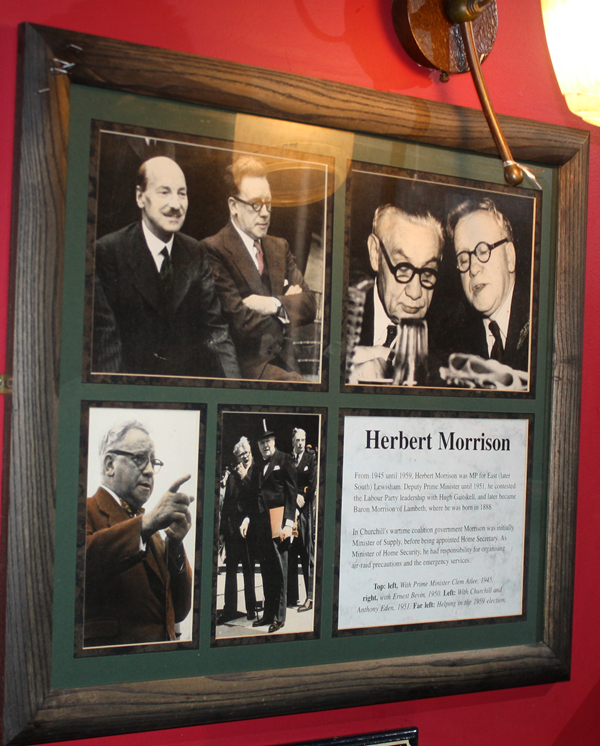
The text reads: From 1945 until 1959, Herbert Morrison was MP for East (later South) Lewisham. Deputy Prime Minister until 1951, he contested the Labour Party leadership with Hugh Gaitskell, and later became Baron Morrison of Lambeth, where he was born in 1888.
In Churchill’s wartime coalition government Morrison was initially Minister of Supply, before being appointed Home Secretary. As Minister of Home Security, he had responsibility for organising air-raid precautions and the emergency services.
Top: left, with Prime Minister Clem Atlee, 1945, right, with Ernest Brown, 1950. Left: with Churchill and Anthony Eden, 1951. Far left: Helping in the 1959 election.
Framed drawings, print and text about Rushey Green.
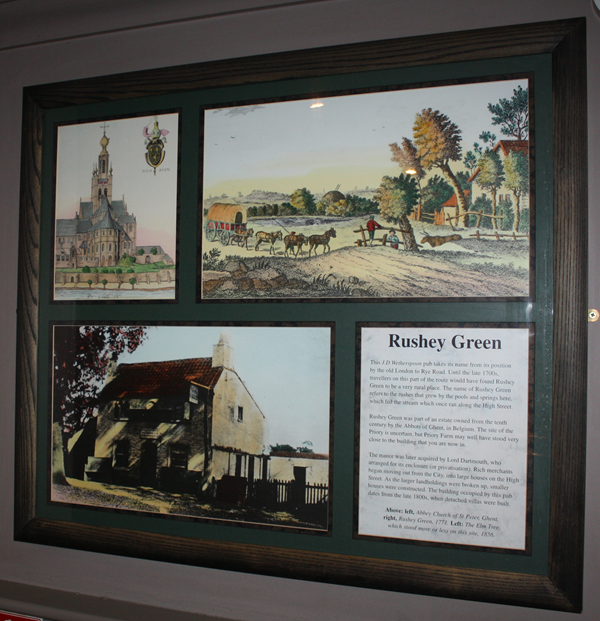
The text reads: This J.D Wetherspoons takes its name from its position by the old London to Rye Road. Until the late 1700s, travellers on this part of the route would have found Rushey Green to be a very rural place. The name Rushey Green refers to the rushed that grew by the pools and springs here, which fed the steam which once ran along the High Street.
Rushey Green was part of an estate owned from the tenth century by the Abbots of Ghent, In Belgium. The site of the priory is uncertain, but Priory Farm may well have stood very close to the building you are now in.
The manor was later acquired by Lord Dartmouth, who arranged for its enclosure (or privatisation). Rich merchants began moving out from the City, into large houses on the High Street. As the larger landholdings were broken up, smaller houses were constructed. The building occupied by this pub dates from the late 1800s, when detached villas were built.
Above: left, Abbey Church of St Peter, Ghent, right, Rushey green, 1771. Left: The Elem Tree, which stood more or less on this site, 1856.
Framed prints and text about Rushey Green Place.
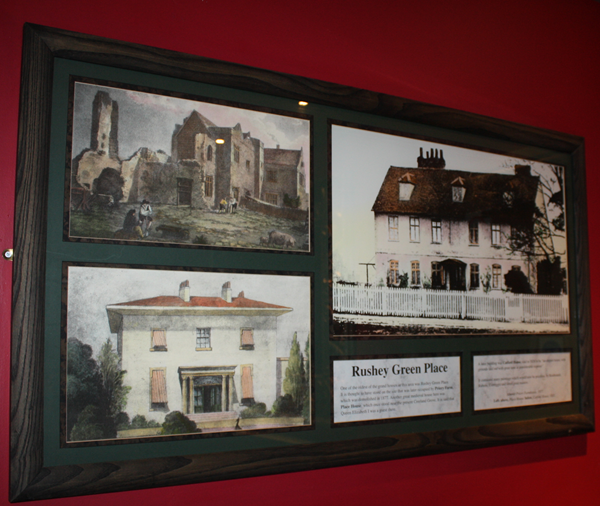
The text reads: One of the oldest of the grand houses in this area was Rushey Green Palace. It is thought to have stood on the site that was later occupied by Priory Farm which was demolished in 1877. Another great medieval house here was Place House, which once stood near the present Creeland Grove. It is said that Queen Elizabeth I was a guest there.
External photograph of the building – main entrance.
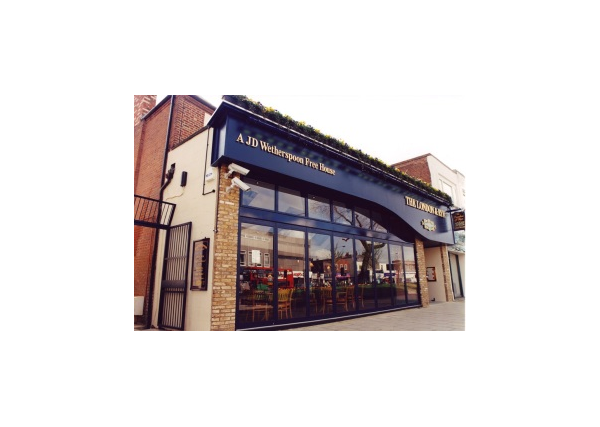
If you have information on the history of this pub, then we’d like you to share it with us. Please e-mail all information to: pubhistories@jdwetherspoon.co.uk